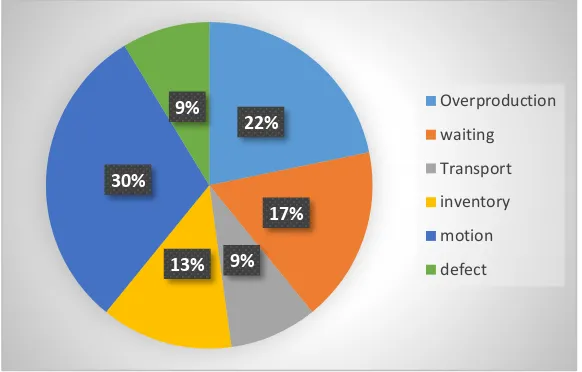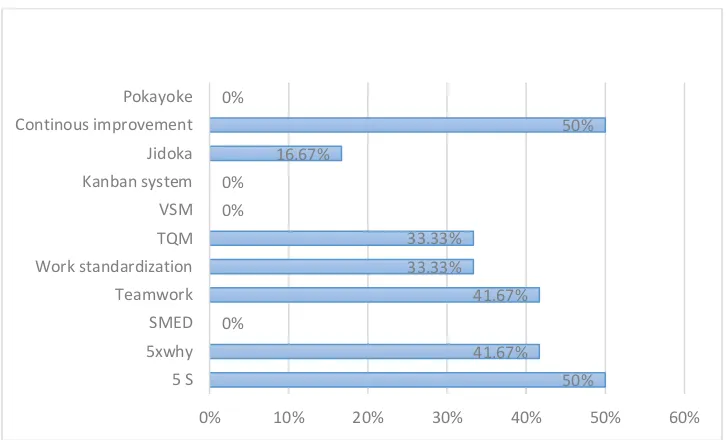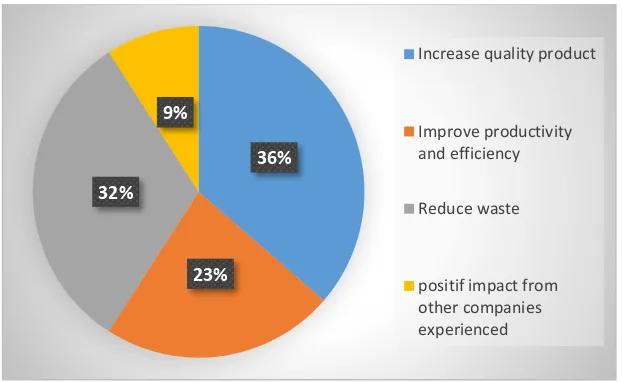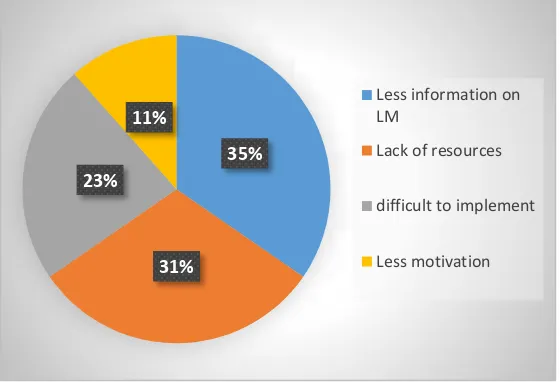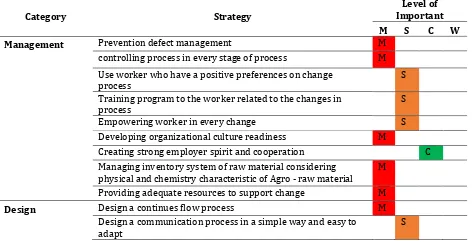CURRENT CONDITION AND RULES OF LEAN IMPLEMENTATION
PRACTICE IN AGRO-SMES: A PRELIMINARY STUDY
Devi Maulida Rahmah*, Totok Pujianto*, Irfan Ardiansah*
*Lecturer in Department of Agro-Industrial Technology, Universitas Padjadjaran devi.maulida.rahmah@unpad.ac.id
Abstract
This research aims to identify current condition and rules of lean manufacturing (LM) implementation in Agro- Small and Medium Enterprises (SMEs). The current condition aspects are identification of waste, LM techniques and methods, the reason and barriers on LM implementation in SMEs. Exploring the behavior of SMEs on implementing LM which supporting to generate productivity and efficiency on production system are important to be identified. Initially, LM concept are implemented in manufacturing industry especially in automotive industry. Nowadays this concept has been implemented by other sector included Small and Medium-size Enterprise. However, it has still a few number of Agro-SMEs implementing LM concept. The data from Indonesia Statistic revealed that the proportion of SME- agro based are in the total of SME in Indonesia. It insinuated that Agro-SMEs has a significant potency for national economic if their productivity increase. LM providing chance to improve productivity and efficiency in. Many research had conducted to explore LM implementation in various sector. Unfortunately, Research on LM implementation in Agro-SMEs has still a few number. Research was conducted in 12 Agro-SMEs around Sumedang and Bandung. Selected SMEs referring to the use of horticulture and plantation commodity as a raw material. The data collected by field observation and deep interview to the owner, management-level, and employer. The data presented through description of qualitative and quantitative analysis. The result shows that the motion becomes a dominant waste in SMEs at 30%, while over production activity contributes waste at 22%, waiting aspect at 17%, inventory at 13 %, defect and transportation at 9%. Motion generates negative impact to work productivity and effectivity, for instance increase of time consume unimportant activity at work, WIP of product, cost for labor, and cost production. In terms of Method and techniques implemented in Agro-SME, Continuous improvement (Kaizen) and 5 S outnumbered to other methods and techniques at 50%. Other method and techniques such as Teamwork and 5Why had contributed at 41.6%, TQM and Work standardization at 33.33%, and Jidoka at 16.67% as well as Kanban system, Value Stream Mapping (VSM), and SMED 0%. In terms of the reason on implementing LM, Improving the quality of product becoming a larger proportion which affecting the LM implementation at 36%. In other hand, knowledge outnumbered to others aspect. It contributes 35% as the most barrier factor on LM implementation.
Key words: Rules of Lean Manufacturing, Agro-SMEs, Current condition.
1. INTRODUCTION
Mourtzis [7] explained that Lean theory, principles and tools, are intended to highlight the value within the company. Specifically, Thanki [10] also explained that lean manufacturing facilitates the organization to improve its business performance in terms of reduced manufacturing lead time and cost,
included Small Medium Business and agriculture business.
Small and Medium Enterprises (SMEs) have contributed over 75% of national income and occupied 97% national employment. The percentage reflects that SMEs have a significant role for national economic. However, Kurniawati [6] claimed that SMEs still have a majority problem on productivity and efficiency while production process especially. There are several factor influencing
SME’s productivity i.e.: Productive resource
(raw material, marketing and distribution, and technology), Human Resource (motivation, education/experience, partnership), and Business environment (bussiness regulation and restriction, financial support, Government policy, and business competition [6].
Antosz [2] also explained that most of Agro-SMEs faced the competitiveness problem. In order to remain competitive in global competition and to be able to meet unprecedented market changes, SMEs must not only design and offer better products and services; but need to improve their manufacturing operations [9].
Improvement in operation process could be conducted by implementing Lean manufacturing. It will generate productivity and efficiency improvement within the process. Directly, LM will reduce the operation waste (included unnecessary motion, over production, waiting on process, transportation, inventory, defect, inappropriate processing and underutilized people) [11]. Its positive direct impact will generate the reducing of production cost and time consuming while production process, and rising the quality of product. LM concept is used to apply in large-size enterprises. Thus,
applying a lean manufacturing concept on small scale industry such as SMEs needs adjustment due to its characteristics such as human resources knowledge and education, readiness of facilities, and using appropriate Technology [8]. Several researchers also revealed that SMEs in Indonesia have a traditional way in terms of their production process, technology and marketing.
Many previous research related to LM implementation in various sector such as service organization (Holde, Basl, Sasiadek), LM Performing in Poland’s Companies (Antosz, Piaceska, Bednarek and Budzaki), and other research which have tried to find proper techniques and methodologies in which LM will be implemented in SMEs in order to developed productivity and efficiency in whole business process.
This research focus on identifying the current condition of LM implementation including typical waste occurred, the reason for LM application, LM method and technique to be implemented. Other aspect which identified in this research is defining the Rules on implementing LM in Agro-SMEs.
2. RESEARCH METHODOLOGY
Research was conducted in 12 SMEs which producing food and plantation product particularly in Bandung and Sumedang. The selected SMEs categorized as a micro, small, and medium size enterprises. The data was collected by field observation and deep interview to the owner, management-level, and employer. Data presented through description of qualitative and quantitative analysis. The object of this research particularly shown by the table (1) :
Table 1. SMEs Categories
Company scale Percentage Product Percentage
Micro 40% Food 100%
Small 20% Food 100%
Medium 40% Vegetable 25%
Research was conducted by identifying the current condition on LM implementation in SME. Specifically, on several aspects, as follow as:
• Waste identification; Wahab [11] explained that Taichi Ohno has identified 8 waste in manufacturing process, included unnecessary motion, over production, waiting on process, transportation, inventory, defect, Inappropriate processing and underutilized people.
• LM Techniques and methods, refer to Antosz [2] outlined several techniques and methods of LM including Poka Yoke, Kaizen (continuous improvement), Jidoka, Kanban system, Value Stream Mapping (VSM), SMED, Total Quality
Management (TQM), Work
Standardization, 5 Why, 5S (Seiri, Seiton, Seiso, Seiketsu, Shitsuke)
• The Reason on implementing LM; The authors inquired the enterprises about the reasons of LM implementation such as for quality of product, productivity
and efficiency, waste management, benchmark from success story on LM implementation of other companies. • Barriers on LM implementation; are
related to internal and eksternal factor for instance Knowledge, Resources, Technical, individual aspect).
Additionally, this research also provides the concept on implementing LM in Agro-SME. This section presents the proposed classification methodology for lean rules. Refer to Mourtzis [7] Classification methodology aims to classify the extracted lean rules into specific categories and inspired by the company’s structure as well as the classification of lean rules both depend on the size, type, and general philosophy of company.
3. RESULT AND DISCUSSION
Type of Waste
The Figure 1 describes the type of waste typically produced by SME while the production process.
Figure 1. Type of Waste in SMEs
Identification of waste commonly produced by SME are essential. It will give a
benefit on providing a guidance of specific and effective strategy on implementing LM. The 22%
17%
9% 13% 30%
9% Overproduction
waiting
Transport
inventory
motion
pie chart above revealed that motion becomes a dominant waste in SMEs at 30%. Refer to the observation and interview process, motion is caused by several condition such as un-ergonomic work station, less work facilities, employer limitation, work force, less work standardization, and unbalance of flow production process. Moreover, motion also generates negative impact to the work productivity and effectivity, for instance increase of time consume unimportant activity at work, work in process (WIP) of product, labor cost, and production cost. Secondly, over production activity contributes 22% to the total of waste. It generated by less knowledge of operation management specifically on scheduling production. SMEs commonly does not apply a rigid LM concept, they have been applying it through a simple way on implementing LM. Thirdly, waiting while the production process was grouped into the three largest of sector contribute to the waste in SME at 17%. And it followed 13 % by inventory, and 9% of defect and transport.
The data will be a consideration for applying a specific technique and method on LM
implementation. SMEs can be focused on reduce the motion waste through several ways such as re-designing work station, applying one-way flow production, and implementing just in time. Moreover, others several and research, assessment process considering every method occurred in company which have the same content and objective to LM theory. SMEs have a different characteristic to the large enterprises. Therefore, the method and technique will be different from each other. The diagram below presents the current condition of LM method and technique implementation in SMEs.
Figure 2. Type of methods and techniques on LM implementation in SME
The bar chart reveals several techniques and methods on LM implementation in SME. Continuous improvement (Kaizen) and 5 s outnumbered to other methods and techniques at 50%. Continuous improvement SME generally applied in a simple way. For instance, in micro and small scale enterprises focus on improving quality of product through self-learning and innovation while production process. However, Kaizen implementation in Medium-size enterprise using an integrated machine which facilitating one flow process. It was causing on reducing of Work in process (WIP) as well as waiting process while production. 5 S (Seiri, Seiton, Seiso, Seiketsu, Shitsuke) are the most common of LM technique implemented in SMEs caused by less resources which required, low cost, and
easy to implemented. Other techniques are Teamwork and 5 Why at 41.6%, TQM and Work standardization 33.33%, and Jidoka 16.67. In other hand, SMEs did not apply Kanban system, Value Stream Mapping (VSM), and SMED.
Reason on implementing LM in SME
Several methods and techniques have implemented by several SMEs. The reason why it implemented successfully should be explored in order to improve the methodology approach on applying other method which did not applied yet. The diagram below will explain the several reason of SME on applying LM.
Figure 3. Reason on implementing LM in SMEs
The reason on LM implementation divided into two categories i.e. internal and external factors. Internal factor is the willingness of SME to increase product quality, to reduce waste, and to improve productivity and efficiency. Improving the quality of product becoming a larger proportion which affecting the LM implementation at 36%. SMEs need to improve their quality of product in order to rise product competitiveness in the broader market. Secondly, reducing waste while
production process also gives a significant percentage on becoming the reason of applying LM. Almanei [1] explained that implementation of LM in any type can bring many benefit, such as reducing waste and improving operating efficiency. Other factors are related to reduce waste, to improve productivity and efficiency, and external factor. Reducing waste contribute 32% to the reason of LM implementation. Waste which generated by the production activities are 36%
23% 32%
9%
Increase quality product
Improve productivity and efficiency
Reduce waste
motion, over production, transport, inventory, defect, and waiting process (delay). Wastes can cause many negative impact to the company. Wahab [11] explained that there is no value created by waste, but it absorbs many resources. Lastly, the willingness to improve productivity and efficiency has contributed roughly a quarter on LM implementation.
In terms of external factor contributing LM Implementation is SMEs finding out
positive impact from other company’s experienced. It insinuated that internal factor becomes a dominated reason factor on implementing LM in SME.
The Barrier on Implementing LM
Refer to Figure 2, it is still a few number of method and technique are implemented by SME. Therefore, it is initial to identify the obstacle on LM implementation in SME.
Figure 4. Barrier on LM implementation in SME
Unsuccessful factor of LM Implementation in SME should be identified in order to improve the proper strategies and approach on LM implementation. The pie chart above illustrating the percentage of barriers on LM implementation. Several factors have identified as a barrier on SMEs perspective. It is related to Knowledge aspect (Less information of LM), Resources aspects (Machine, technology, cost, employer skill), Technical aspect (Difficult to implement), Internal/ personal aspect (Motivation).
Knowledge outnumbered to others aspect. It contributes 35% as the most barrier factor on LM implementation. It indicated that less information about LM becoming the largest reason on implementing LM. However, internal factor such as motivation of SME to
implement has the lowest percentage on becoming barrier in LM implementation. It insinuated that most of SME are motivated to apply LM. However, most of them the did not have a specific knowledge of LM.
Lean Rules for Management and Design in SMEs
Refer to Mourtzis [7] the rules of LM in molding SMEs, this research will elaborate LM concept in manufacturing industry to be implement in Small and Medium scale- Industry (SME) Agro based. Applying many various technique and tools need an adjustment due to the current LM condition in SMEs. In order to gain a significant impact to
the SME’s performance, LM could be an
effective way if applied properly. 35%
31% 23%
11%
Less information on LM
Lack of resources
difficult to implement
The strategy to implement LM also should be considering the factor related to the successful implementation Lean. Almanei, [1] summarized the successful factor on implementing Lean in SMEs as follow as:
• Organizational culture and ownership • Developing organizational readiness • Management commitment and
capability
• Providing adequate resources to support change
• External support from consultant in the first instance
• Effective communication and engagement
• Strategic approach to improvements
• Teamwork and join-up whole system thinking
• Timing to set realistic timescale for change and to make affective use of commitment and enthusiasm for change
Several rules of LM in Agro-SMEs have been collected by the literature study, field observation, and interviewing stakeholders from different hierarchical level on Agro-SMEs. Mourtzis [7] rules are categorized into Manufacturability, Design, Management, and communication. Level of important of each rules will be described using MoSCow. The Color-code are used to identify the level of important Mourtriz [7].
Table 2. Level of Important of Rules of LM Implementation
Level of Important Symbols
High importance M
Medium Importance S
Medium-Low importance C
Low Importance W
Table 3. Rules of LM Implementation in Agro-SME
Category Strategy
Level of Important
M S C W
Management Prevention defect management M
controlling process in every stage of process M
Use worker who have a positive preferences on change process
S
Training program to the worker related to the changes in process
S
Empowering worker in every change S
Developing organizational culture readiness M
Creating strong employer spirit and cooperation C Managing inventory system of raw material considering
physical and chemistry characteristic of Agro - raw material M
Providing adequate resources to support change M
Design Design a continues flow process M
Design a communication process in a simple way and easy to adapt
Category Strategy
Level of Important
M S C W
Developing database management system in a simple way and easy to understand
S
Use a standard component on designing every process C
Design work station considering ergonomic aspect M
Designer should have deep understanding on whole process W Designer should try to imply the past experience in the same
case C
Design use a modern system W
Design layout facilities considering the typical and flow of
process M
Communication Intensive communication to the worker M
Intensive communication to the supplier M Intensive communication to consumer M Use a sign (Such as kanban card) to communicate within the process
Use un-direct mechanism (Technology) for critics and
suggestion C
Manufacturability Optimize on Use a possible technology M
Pay attention to the machine cycle M Intensive and effective controlling M
Use a high technology machine C
Use a new methodology S
Use a simple way to identify a wrong process and machine in
order to minimize defect M
4. CONCLUSION
1. The current condition aspects on LM implementation are including identification of waste, LM techniques and methods, the reason and barriers on LM implementation in SMEs
2. Motion becomes a dominant waste in SMEs at 30%, while over production activity contributes waste at 22%, waiting aspect at 17%, inventory at 13 %, defect and transportation at 9%.
3. Method and Techniques which applied in Agro-SME, Continuous improvement (Kaizen) and 5S outnumbered to the other at 50%. Other method and techniques such as Teamwork and 5Why had contributed at 41.6%, TQM and Work standardization at 33.33%, and Jidoka at 16.67% as well as
Kanban system, Value Stream Mapping (VSM), and SMED 0%.
4. In terms of the reason on implementing LM, Improving the quality of product becoming a larger proportion which affecting the LM implementation at 36%. In other hand, knowledge outnumbered to others aspect. It contributes 35% as the most barrier factor on LM implementation.
5. The Rules of LM implementation practice in SMEs was identified.
REFERENCE
[1] Almanei. M., Salonitis, K., Xu. Y. 2017. Lean Implementation Frameworks: The Challenges for SMEs. Procedia CIRP 63 (2017) 750 – 755.
– Study Result. Procedia Engineering 182 (2017) 25 – 32.
[3] Cirjaliu. B., Draghici. A. 2016.Ergonomic Issues in Lean Manufacturing. Procedia- Social and Behavioral Sciences 221 (2016) 105 – 110. [4] D’ Antonio, G., Bedolla. J. S., Chiabert. P.
2017. A Novel Methodology to integrate Manufacturing Execution System with the Lean Manufacturing approach. Procedia manufacturing 11 (2017) 2243 – 2253.
[5] Hartini. S., Ciptomulyono. U. 2015. The Relationship Between Lean and Sustainable Manufacturing on Performance: Literature review. Procedia Manufacturing 4 (2015) 38 – 45.
[6] Kurniawati. D., Yuliando. H. 2015. Productivity Improvement of Small Scale Medium Enterprises (SMEs) on Food Products: Case at Yogyakarta Province, Indonesia. Agriculture and Agricultural Science Procedia 3 (2015) 189 – 194.
[7] Moutzis. D, Papathanasiou. P., Fotia. S. 2016. Lean rules Identification and Classification for Manufacturing Industry. Procedia CIRP 50 (2017) 198 – 203.
[8] Rahmah. D. M., Rizal. F., Rosalinda. S. 2017. The Changes on Scale-Up Agriculture Business Transformation Process in Rural area. Journal of Industrial and Information Technology in Agriculture (JIITA) Vol 1 No 1 (2017) 24 – 32.
[9] Rahman. N. A. A., Sharif. S. M., Esa. M. M. 2013. Lean Manufacturing Case Study with Kanban System Implementation. Procedia economic and Finance 7 (2017) 174 – 180. [10] Thanki. S., Govindan. K., Thakkar. J. 2016.
An Investigation on Lean-Green Implementation Practices in Indian
SMEs Using Analytical Hierarchy Process (AHP) Approach. Journal of Cleaner Production 135 (2016) 284 – 298.
